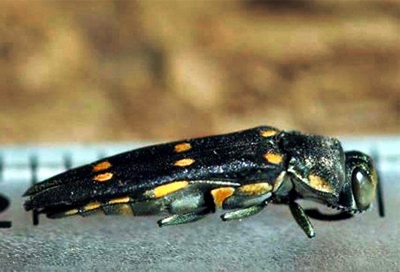
The agony of the oaks
As if life weren’t difficult enough for California’s majestic oaks, they now face a brand new adversary. Already burdened by drought, wildfires, firewood harvesting and Sudden Oak Death, the Riverside Press-Enterprise reported in December that goldspotted oak borer hitchhiked from Arizona or Mexico a few years ago and is now attacking Southern California oaks.
It was identified in the Golden State in 2006 and to date has besieged coast live oak, California black oak and canyon live oak, according to an article in the December 2009 issue of UC's Oaks 'n' Folks newsletter written by Doug McCreary, UC Berkeley Cooperative Extension natural resources specialist. So far, more than 17,000 oaks have succumbed to the borer.
Unlike pests that target weakened or stressed trees, the GSOB (also called "Golden SOB" by some, according to McCreary) attacks large, vigorous and healthy trees, including those in urban yards.
"We are turning a big crank on this bug right now," the Press-Enterprise article quoted Mark Hoddle, an entomologist and director of UC Riverside's Center for Invasive Species Research. "Can you imagine Southern California without oak trees? It would be a disaster."
Even more alarming, officials believe the pest's range in California will likely expand. It's progress can be slowed with the public's help. The Press-Enterprise published the following tips for stemming the spread of GSOB:
-
Do not transport oak firewood into or out of campgrounds or parks
-
Chip infested oak wood to 1-inch pieces
-
Cover stored oak firewood with 6 mm, UV-stabilized, durable plastic tarps in the spring. Secure all the edges of the tarp to the ground to prevent beetles from escaping
-
Season oak firewood. Remove the bark and place the wood in direct sunlight
The UCR Center for Invasive Species has created a Web page with information about and photos of GSOB and damage caused by the pest. In addition, a two-page Pest Note on gold spotted oak borer, with 14 color photos, may be downloaded from the Web.

Goldspotted oak borer.
Posted by Pamela Kan-Rice on January 6, 2010 at 5:18 PM